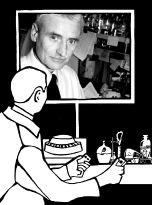TODAY, BIOTECHNOLOGY dominates the high-tech headlines, grabbing the attention computing and communications dominated over the last 20 years. But if the research direction is changing, the driving force remains the same: public money invested in nonprofit science.
The Fred Hutchinson Cancer Research Center’s Lee Hartwell deserves every inch of ink he got last week for his Nobel Prize. But the National Institutes of Health deserve at least as much applause for investing over $40 million in Hartwell over the decades. Back in 1970, it wasn’t all that obvious that tinkering with baker’s yeast would provide basic insights into how living cells manage to multiply.
And for all the budget-cutting, privatizing, anti-science rhetoric one hears from Washington, federal money continues to flow into basic research, and, to an astonishing degree, into the Pacific Northwest. In the course of just a month or so, researchers at the University of Washington have been granted over $34 million for the kind of deep-structure study that, by its nature, can’t produce predictable payoffs, but just as surely will, like Hartwell’s, be worth its weight in gold one day.
The smallest of the new projects is also the best defined: Biochemist Wim Hol’s $4.4 million will go to finding ways to extract functional proteins from protozoa (single-celled animals that cause human diseases from dysentery to syphilis) in order to find targets to interfere with their reproductive cycle or reduce their virulence.
The most expansive of the three projects is also the one with the most potential for controversy. The National Human Genome Research Institute (NHGRI) has allotted $15 million to a powerhouse team of UW researchers headed by geneticist Maynard Olson. Their goal: to devise methods of doing for individual human beings what the Human Genome Project did for humankind in general.
Even before the draft sequences of the human genome were published last year, it was becoming clear that a huge reservoir of genetic variation between humans consists of tiny—one “bit”— differences between one person’s three billion-bit genome and another’s.
Some of these SNPs (short for “single nucleotide polymorphisms” and pronounced “snips”) are known to have profound impacts on health. This week it was announced that a single SNP appears to impair its carrier’s ability to string sounds together into language. (As it happens, one thrust of Olson’s UW research is directed at tweezing out the differences between the human genome and those of our nearest, yet speechless, relatives, the primates.)
The difficulty is that currently such an individualized map would cost hundreds of millions to construct. And the technologies used to map a kind of averaged-out human genome in the Human Genome Project don’t lend themselves to the far finer detail work required.
The so-called PCR (polymerase chain reaction) technique is a terrific way of generating analyzable quantities of short chunks of DNA; it’s hopeless at producing strands a thousand times as long that Olson’s group needs to work on.
An older technique for producing enough genetic material to analyze—planting chromosome-sized chunks of human DNA in microorganisms and encouraging them to multiply—already exists, but it’s cumbersome and slow. A main focus of the UW research goes toward finding ways of automating the process to make it speedier and cheaper.
Some people feel that any attempt to map the fine structure of interhuman differences is an invitation to a revival of racism, this time with the sanction of science. This is not a concern to be brushed aside. But research like Olson’s can actually help to move beyond dubious generalities of “race” so we can focus on the unique genetic makeup of each individual, to the extent it has an impact on the individual’s health and well-being.
If Olson’s group is taking a down-to-earth look at making established technology more efficient, the UW group awarded an unprecedented second $15 million from the NHGRI is shooting for the moon. Most biological research is based on studying the average behavior of large numbers of cells. Electrical Engineering prof Deirdre Meldrum and her group would like to observe one cell at a time.
The machinery for doing this does not exist. Meldrum & Co. propose to invent it, based on microengineering techniques developed to etch, wire, and drive the nano-scale circuits on computer chips. If they succeed, we will be able to watch as a cell switches genes on and off as part of normal housekeeping or in response to external stimuli, and do it without damaging the cell—ideally without the cell knowing anybody’s watching.
Research doesn’t get any more blue-sky than that. But one way or another, the Meldrum team’s vision is going to be realized. When that happens, $15 million is going to look like pocket change. But as things are these days, pocket change is great to have around.








